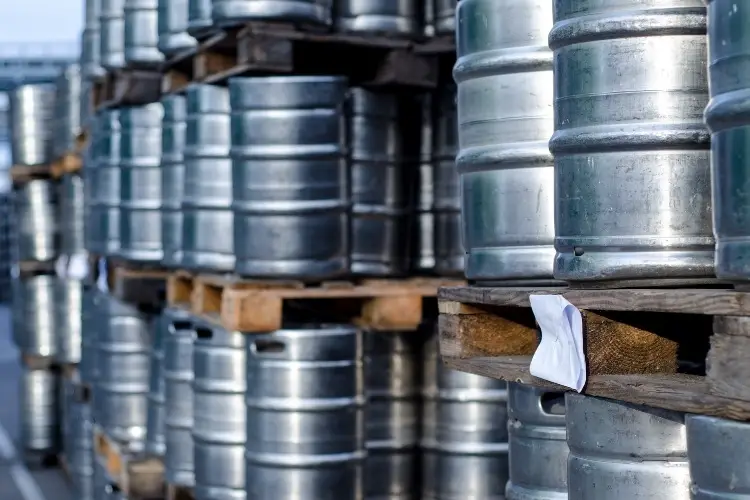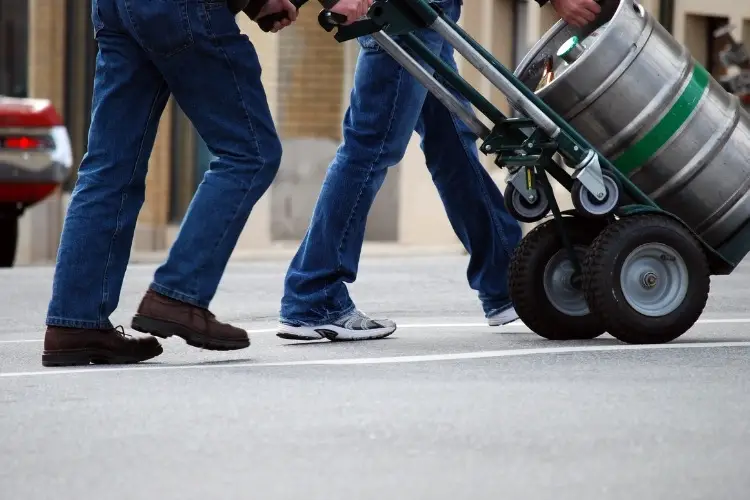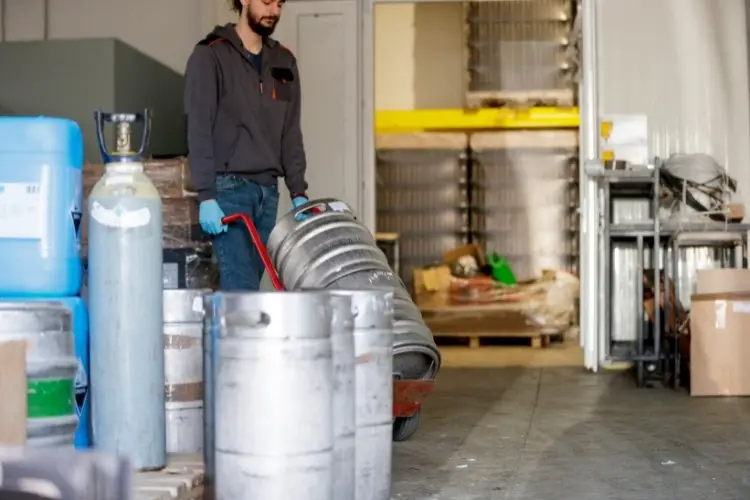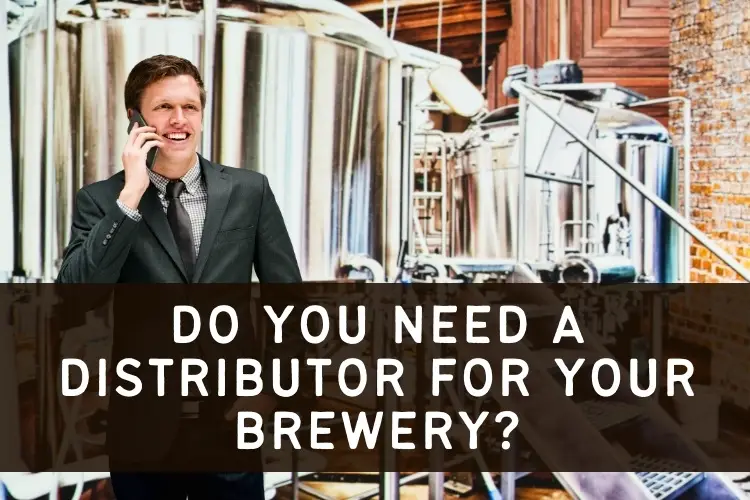One of the best things and worst things about the US is its 50 states, with thousands of counties and a multitude of laws specific to each. There is individualism, character, and what one brewery can do across the state line you can’t. It all depends on where you live.
States have liberalized their laws in recent years to allow craft brewers more leeway in how they manage and distribute their products. Find a distributor that is right for you in size, scope and goals. Do the research before making any assumptions.
I’ll use North Carolina as a baseline example as that’s where I was a rockin’ and a rollin’ and what not. I was a brewery founder and Master Brewer there in the 90’s and aughts. Most of the following reflects my direct experience.
The 3-tiered system
The US operates under this system in some form 49 US states excluding Washington. This is a system wherein manufacturing, distribution, and retail sales of alcoholic malt beverages must remain wholly separate.
In 1933, the 21st Amendment to the US Constitution repealed Prohibition and implemented a set of rules (left up to individual states) on how to organize tax revenue.
In simplified form, it is as follows.
- Manufacturing: If you make it, you can’t ship it.
- Distribution: If you ship it you can’t make it, nor retail it.
- Retail Sales: If you retail it, you cannot do either of the other two.
In the 1980’s with the first revival of microbreweries in the US, NC amended its laws. It did allow microbreweries to do all three, provided they made no more than 10,000 barrels a year. (1 bbl. = 31 gallons/ 2 kegs). The production ceiling in NC is higher now, as we’ll revisit shortly.
Back in the 80’s, brewpubs popped up and the novelty of brewing and selling beer on-premises was reborn. This was a reality that had nearly died in the years following World War II.
Also note, even if you work for a brewery and can retail and distribute your product, you may not work for another company that distributes or retails beer. You then fall under the original confines of the law.
Why the 3-tiered system?
Part of the reason the 3-tiered system was put in place to protect the big brewers from competition, but mostly to levy taxes.
Small brewers hadn’t the capital to set-up distribution companies. They hadn’t marketing dollars and brand recognition to own (figuratively speaking) bars and pubs– that is to dominate their sales with product placement.
In NC, the brewpub law allowing this exception was seen as a loophole law. These tiny breweries were not seen as a threat.
Finding a Distributor

How to find a good distributor for you?
Talk to other brewers, talk to bar owners, find out who gives good service and who fills a niche that your products can fill. Meet with 3-4 different distribution houses and see who is most open to communication and mutual growth.
Be cautious when signing away distribution rights with someone. Once you do, they own your brand exclusively in the agreed upon region and can do with it as they please, including letting it go stale on the warehouse floor.
Regardless of the law, most microbrewers large and small sign with a distributor. A distributor has a fleet (large or small) of trucks and vans (large or small) and most importantly, relationships with retail businesses, fostered over months and years by the management, owners, and sales reps.
What are distributors and what do they do?
A distributor stores your beer at cellar temp keeps the lines clean and makes a reasonable effort to sell and promote the product. They cooperate with the producer in good faith and are a link to the retail outlet’s production brewers depend on.
Finding a good match is a challenge. Even a small distributor may have 150 products; for example, 100 wines and 50 brands of beer.
A distributor must sell dozens of brands of beer and wine to make money and needs incentive to sell yours. Therein lies the rub. It is your job to build your relationship with the distributor, so they keep your product on their radar, even the top 10 (or 25!).
What are ways the brewer can help the distributor?
Brewers must be creative to gain traction for their brand within the distributorship itself. They pay bounties on tap accounts – cash kickbacks for beer placement – hold parties and Bar-B-Qs for staff and give away lots of free schwag (promotional items).
There are distributors and/ or beer companies who call their sales reps assassins. Welcome to the modern world of market hyper-competition.
At the end of the day, the distributor’s job is to store and deliver the beer, possibly clean the beer lines, and take their 25% commission. If they do more than that for you, great, you may have found a good partner.
Building the relationship
If the beer is excellent and you have good people in the org, it is possible to foster a profitable relationship with the distributor.
Reach out to the retailers yourself and get to know them. When they are aware of you, they will pass it on. Provide point of sales and hot visuals for your brand so patrons can see you. This fosters the retail-distributor relationship, bringing goodwill from both parties back towards the brewer.
These days, good distributor relationships are increasingly difficult to find. There are simply too many products. There has to be an incentive. The real question for the brewer is how to create that incentive?
The Good News – Selling your rights
Once the brewery has established relationships and a presence in vital markets, you may sell the rights to your brand.
The brand becomes sought after. A distributor needs a strong local brewery to attach themselves to. Tens or hundreds of thousands of dollars may be paid for your distribution rights. Play your cards tight to the chest.
Own your Home Market
Back in the day, with only 6-8 brewers in Asheville, French Broad- my brand, was in the high-middle of the pack. There were still dozens of brands of micro-competition, I am speaking strictly of Asheville beer.
We operated by one maxim. When people thought of Asheville, they had to think of French Broad.
This is owning your home market.
We had a tiny taproom, and self-distributed. That allowed us to have a personal relationship with people in the business: bars, beer stores, restaurants, and clubs.
It was as simple as having a van and running deliveries as needed.
Most keg orders went out Thursday and small ones went out whenever they were needed. In the late 2000-aughts, we signed a deal with a local distributor to deliver our cans, while we retained rights to draft sales.
We kept the 25% on draft sales and maintained the relationships ourselves.
The distributor did a good job with our cans and the relationship was amicable.
FBBC was a smaller brewery, peaking at about 5000 bbl. at that time. If you have 1-3 vehicles and can make the runs, do it yourself. We didn’t have refrigerated vehicles, we just made it quick. You can use keg jackets as well.

Self-Distribution
For many years in NC, the self-distribution limit for microbreweries was 10,000. Then it was upped to 25,000 in 2003.
This was largely due to the efforts of a gentleman named Bill Sherril, who helmed the Red Oak Brewery (old Spring Garden) in the early 1990’s. He was on the verge of eclipsing the 10K mark in 2003 or so and rightfully wanted to hold on to his statewide distribution rights.
Self -Distribution – An Industry Game Changer

Red Oak Brewing has their fleet of vans and trucks. They make weekly circuits statewide and visit every single customer whether they need it or not.
The lines (I assume) were cleaned on schedule and a customer virtually never ran out of beer. I have to say that is one hell of a model.
Also, they were among the first to introduce 3- and 5-gallons kegs (12 and 20 Liters I believe). You could fit them in small spaces. They make German-style lagers with all imported ingredients and sourced much of their equipment there.
As Red Oak grew, they literally fit their beer between the cracks of the market (space inside the keg boxes), gave outstanding service and created fierce loyalty. It was nearly impossible to displace a Red Oak Tap. Few of us had smaller kegs anyway.
Now ⅙ bbl. kegs are the industry standard, due to variety and tap space.
The Self-distribution cap increases
With signatures, phone calls to Raleigh, the 10K barrel cap was raised to 25K in 2003. I got a call from Bill Sherril himself, imploring me to call my state congressman’s office on such and such a day lending support, which I did.
Even more recently, in 2019, the limit has been raised. It is now 100,000 bbls. That said, it was considered a compromise. Anything over 50,000 barrels of wholesale distribution must be made by a distributor.
It is quite complex and quite a political fight, taking 20 years to unfold. Please see Charlotte breweries want to expand. But a big campaign donor is getting in the way, for an interesting read.
Last Thoughts
One issue still sticks in my craw, and it is part of the 2019 compromise.
Breweries under the 25,000-bbls mark will no longer need to show good cause in order to terminate a distribution agreement. They just need to provide five days’ notice and pay fair market value. (Crowell, 2019, Craft Brewing Business)
Before 2019, brewers had to prove distributors did a bad job before you bought your own beer back from them. Now, you get 5 days to write the distributor who doesn’t sell your beer a check at fair market value- yet to be determined.
Warning friends! That figure will be in the tens if not hundreds of thousands of dollars and the distributors have lawyers that say so. It is an on-going puzzle.
Luckily, the avenues have grown wider for craft and micro-brewers who have ever-widening economic muscle.
KMB Consulting can assist you in all of your challenges, large or small. Brewers need support and input. It is an artisanal craft, refined by years in the brewhouse. It is also a uncommonly specialized business.
Interested in a start-up or expansion? From conception to construction and pilot brews, we have the experience.
Today’s brewers have puzzles that need a fresh perspective. I’ve walked in your shoes. I know the victories and struggles that come with the brewer’s life. Check out our Pro Brewing Consulting Service and reach out to us. No problem is unfixable.

